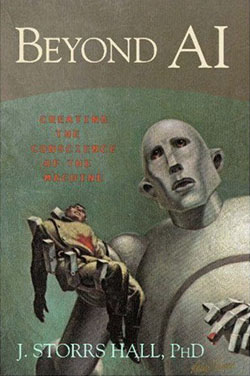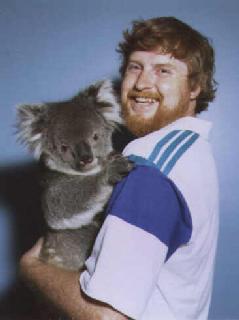Dr. J. Storrs “Josh” Hall
J. Storrs “Josh” Hall, Ph.D. is an independent scientist and author. He is known as the originator of the Utility Fog concept and was founder and moderator of the sci.nanotech newsgroup for a decade.
Josh’s most recent book is Beyond AI: Creating the Conscience of the Machine. It is about the (possibly) imminent development of strong AI, and the desirability, if and when that happens, that such AIs be equipped with a moral sense and conscience. This is an outgrowth of his essay Ethics for Machines.
His previous book is Nanofuture: What’s Next For Nanotechnology. It is about real nanotechnology, i.e. molecular machines (as opposed to films and powders re-branded “nanotech” as a buzzword.) He earned the 2006 Foresight Nanotech Institute Communications Prize and the 2007 Bela Kornitzer Prize for Nanofuture.
The word autogeny means, literally, “born of itself”. He uses it in Nanofuture to refer to systems, such as proposed nanomanufacturing systems, that are capable of building all the parts they consist of, and can thus be bootstrapped from small kernels if properly designed. He finds that the term fits very well with his concept of how a human mind develops, and that this is a very fruitful way of thinking about what goes on in the mind. (Compare this with Maturana’s term “autopoiesis”, which has a similar meaning in the philosophy of biology.)

Josh was the founding Chief Scientist of Nanorex, Inc, which is developing a CAD system for nanomechanical engineering. He remains a member of Nanorex’s Scientific Advisory Board, as well as a Research Fellow of the Institute for Molecular Manufacturing.
His research interests include molecular nanotechnology and the design of useful macroscopic machines using the capabilities of molecular manufacturing. His background is in computer science, particularly parallel processor architectures, artificial intelligence, particularly agoric and genetic algorithms as used in design, and reversible computing.
He’s a proponent of replacing roads and internal combustion vehicles with flying cars. They are some of the milder innovations that nanotechnology could make not only possible, but economical (not to mention safe) as well. Another is space travel.
Josh authored A Reversible Instruction Set Architecture and Algorithms, Nanocomputers and Reversible Logic, Architectural considerations for self-replicating manufacturing systems, Utility fog: A universal physical substance, An Electroid Switching Model for Reversible Computer Architectures, The Age of Virtuous Machines, Kinds of Minds, Is AI Near a Takeoff Point?, Runaway Artificial Intelligence?, and What I want to be when I grow up, is a cloud, and coauthored Highest Utility First Search Across Multiple Levels of Stochastic Design and Rutger’s CAM2000 Chip Architecture. Read the full list of his publications!
He was co-inventor of adiabatic logic, independently but concurrently with Merkle and Athas. He published one of the earliest descriptions of a reversible/dissipation-limited instruction set architecture. Adiabatic logic is an architectural necessity for energy-efficient computation at the molecular level.
He invented a method for utility-based optimization of multi-level search-based stochastic design. He designed and implemented a program which designed pipelined microprocessors given a description of the desired instruction set.
He designed the Linear C language for associative processing. Linear C was the first (and still the only) language which permitted parallelization of a legacy sequential code on a completely incremental, statement-by-statement basis.
He published the first parallel version of Dijkstra’s shortest path algorithm for content addressable memory (CAM). This was followed by a large number of other novel CAM algorithms for various applications, including AI, database, vision, graphics, and compilers.
Josh earned his B.A. (cum laude) in Mathematics from Drew University in 1976, Ciba-Geigy award in Mathematics. He earned his M.S. in Computer Science from Rutgers University in 1994 and his Ph.D. in Computer Science from Rutgers University in 1994 with the thesis “Associative Processing: Architectures, Algorithms”. He holds the patent Method of producing optimized designs using computer systems and designs produced therefrom.
Watch his talk Asimov’s Laws of Robotics Revised. Read the transcripts of What Could A Nanofactory Make? and A Door Into Summer. Enjoy the poems How The Schmirk Stole Nanotechnology and A Visit from Saint Assembler.
